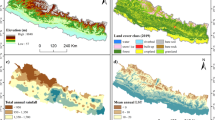Abstract
This paper explored the spatio-temporal patterns of vegetation productivity based on MODIS-NDVI and spatial auto-correlation analysis in the grassland of Inner Mongolia, China during 2011–2013. Two statistics indices, i.e., spatial auto-correlation and semi variance function, were applied in the analysis. The results showed that: (1) at regional scale, the NDVI presented a positive spatial auto-correlation, while at local scope NDVI showed high-high auto-correlation in the eastern part of the study region where the vegetation cover was relatively best. In contrast, NDVI displayed low-low auto-correlation in the western area where the vegetation cover was poor. (2) During 2011 to 2013, the structural factors explained 70 % of the total spatial variations impacting the vegetation cover, and the annual precipitation also played a significant role in the spatial variation of vegetation cover.
Similar content being viewed by others
References
Paruelo, J.M., Epstein, H.E., Lauenroth, W.K., et al.: ANPP estimates from NDVI for the central grassland region of the United States. Ecology 78(3), 953–958 (1997)
Oliver, M.A., Webster, R.: A tutorial guide to geostatistics: computing and modelling variograms and kriging. CATENA 113, 56–69 (2014)
Jaime Gómez-Hernández, J., Horta, A., Jeanée, N.: Geostatistics for environmental applications. Spat. Stat. 5, 1–2 (2013)
Li, Y., He, D.: The spatial and temporal variation of NDVI and its relationships to the climatic factors in Red River Basin. J. Mt. Sci. 3, 333–340 (2009)
Zhang, X., Hu, Y., Zhuang, D., et al.: NDVI spatial pattern and its differentiation on the Mongolian Plateau. Geograph. Res. 28(1), 10–18 (2009)
Zhao, C., Shu, H., Xuan, G.: Temporal-spatial analysis of vegetation change based on MODIS images. Sci. Surveying Mapp. 35(5), 173–175 (2010)
Wang, X., Jiang, D., Ma, D.: Spatial auto-correlation analysis of vegetation cover using MODIS NDVI time series data-regional comparison of Shandong Peninsula and Liaodong Peninsula. J. Arid Land Resour. Environ. 27(10), 24 (2013)
Crabtree, R., Potter, C., Mullen, R., et al.: A modeling and spatio-temporal analysis framework for monitoring environmental change using NPP as an ecosystem indicator. Remote Sens. Environ. 113, 1486–1496 (2009)
Lin, G.-F., Chen, L.-H.: A spatial interpolation method based on radial basis function networks incorporating a semivariogram model. J. Hydrol. 288, 288–298 (2004)
Aragao, L.Y., Shimabukuro, S.F., et al.: Landscape pattern and spatial variability of leaf area index in Eastern Amazonia. For. Ecol. Manag. 211(3), 240–256 (2005)
Zeng, L., Levy, G.: Space and time aliasing structure in monthly mean polar‐orbiting satellite data. J. Geophys. Res.: Atmos. (1984–2012) 100(D3), 5133–5142 (1995)
Overmars, K.P., De Koning, G.H.J., Veldkamp, A.: Spatial autocorrelation in multi-scale land use models. Ecol. Model. 164(2), 257–270 (2003)
Acknowledgments
This work was Supported by “Key Laboratory for National Geographic State Monitoring of National Administration of Surveying, Mapping and Geoinformation”, the “Strategic Priority Research Program - Climate Change: Carbon Budget and Relevant Issues” of the Chinese Academy of Sciences (No. XDA05050402) and the Natural Science Foundation of China (Grant Nos. 41071249 and 41371371).
Author information
Authors and Affiliations
Corresponding author
Editor information
Editors and Affiliations
Rights and permissions
Copyright information
© 2016 Springer-Verlag Berlin Heidelberg
About this paper
Cite this paper
Wang, Z., Li, G., Dai, Y., Wang, Z., Sha, Z. (2016). Assessment of Spatio-Temporal Vegetation Productivity Pattern Based on MODIS-NDVI and Geo-Correlation Analysis. In: Bian, F., Xie, Y. (eds) Geo-Informatics in Resource Management and Sustainable Ecosystem. GRMSE 2015. Communications in Computer and Information Science, vol 569. Springer, Berlin, Heidelberg. https://doi.org/10.1007/978-3-662-49155-3_70
Download citation
DOI: https://doi.org/10.1007/978-3-662-49155-3_70
Published:
Publisher Name: Springer, Berlin, Heidelberg
Print ISBN: 978-3-662-49154-6
Online ISBN: 978-3-662-49155-3
eBook Packages: Computer ScienceComputer Science (R0)




